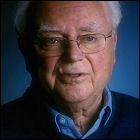 Astronomer Dr. Frank Drake, one of the founders of SETI (the Search for Extra-Terrestrial Intelligences), dies at the age of 92. His fascinating with searching for life on other worlds began at a young age, and defined much of his life and career. In the 1960s, as part of a lecture, he devised the Drake Equation, a formula for calculating a very rough estimate of the possible number of civilizations capable of communicating across interstellar distances; this equation has been debated and challenged over the years, as well as gaining mainstream recognition after being cited in popular science programming (such as Carl Sagan’s Cosmos) and science fiction as well. In the 1970s, Drake and Sagan joined forces to create the “messages in bottles” affixed to the earliest space probes expected to break free of the solar system, including the Pioneer plaques and the golden records attached to Voyagers 1 and 2.
Astronomer Dr. Frank Drake, one of the founders of SETI (the Search for Extra-Terrestrial Intelligences), dies at the age of 92. His fascinating with searching for life on other worlds began at a young age, and defined much of his life and career. In the 1960s, as part of a lecture, he devised the Drake Equation, a formula for calculating a very rough estimate of the possible number of civilizations capable of communicating across interstellar distances; this equation has been debated and challenged over the years, as well as gaining mainstream recognition after being cited in popular science programming (such as Carl Sagan’s Cosmos) and science fiction as well. In the 1970s, Drake and Sagan joined forces to create the “messages in bottles” affixed to the earliest space probes expected to break free of the solar system, including the Pioneer plaques and the golden records attached to Voyagers 1 and 2.
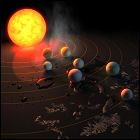 NASA announces the discovery, via the Spitzer Space Telescope, of a system of seven Earth-sized worlds orbiting the star TRAPPIST-1, only 40 light years from Earth’s solar system. Though water may exist in some state on all seven of the planets, three of them are thought to be orbiting within the “Goldilocks zone” in which liquid water would be abundant, making life possible on the surfaces of those planets.
NASA announces the discovery, via the Spitzer Space Telescope, of a system of seven Earth-sized worlds orbiting the star TRAPPIST-1, only 40 light years from Earth’s solar system. Though water may exist in some state on all seven of the planets, three of them are thought to be orbiting within the “Goldilocks zone” in which liquid water would be abundant, making life possible on the surfaces of those planets.
 Widely regarded as one of the 20th and 21st centuries’ finest minds in the fields of theoretical physics and cosmology, Professor Stephen Hawking dies at the age of 76, having suffered from ALS (better known as Lou Gehrig’s Disease) for over 50 years. He far outlived the few years he was expected to live when he was diagnosed in 1963. In that time, he co-authored a 1970 paper which referred back to Einstein’s Theory of General Relativity to lend great credibility to the then-new (and not widely accepted) theory of the universe’s origins in a “big bang”. Later that same year he began working on research that would eventually lead to the theory that black holes would emit a signature radiation, dubbed Hawking radiation, though those emissions had yet to be observed directly at the time of Hawking’s death. His best-selling 1988 book, “A Brief History Of Time”, propelled Hawking (and his remarkable survival story) into the public eye, though by this time he was wheelchair-bound and reliant on a speech synthesizer to communicate with others.
Widely regarded as one of the 20th and 21st centuries’ finest minds in the fields of theoretical physics and cosmology, Professor Stephen Hawking dies at the age of 76, having suffered from ALS (better known as Lou Gehrig’s Disease) for over 50 years. He far outlived the few years he was expected to live when he was diagnosed in 1963. In that time, he co-authored a 1970 paper which referred back to Einstein’s Theory of General Relativity to lend great credibility to the then-new (and not widely accepted) theory of the universe’s origins in a “big bang”. Later that same year he began working on research that would eventually lead to the theory that black holes would emit a signature radiation, dubbed Hawking radiation, though those emissions had yet to be observed directly at the time of Hawking’s death. His best-selling 1988 book, “A Brief History Of Time”, propelled Hawking (and his remarkable survival story) into the public eye, though by this time he was wheelchair-bound and reliant on a speech synthesizer to communicate with others.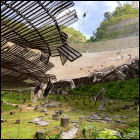 After being in operation for most of the past 57 years, the fate of the Arecibo Radio Telescope facility is sealed by the failure of two major tension cables suspending the 900-ton equipment platform over the dish carved into the Puerto Rican countryside. Engineering safety assessments reveal that other cables are on the verge of failure, which could lead to an “uncontrolled collapse” putting the lives of nearby researchers and engineers at risk. As a result, the Arecibo facility – originally a project of Cornell University but now managed by the University of Central Florida – is slated for demolition as soon as is safely possible, provided its aging superstructure doesn’t collapse under its own weight first. The observatory’s physical superstructure had been under close observation since suffering major damage from Hurricane Maria, which caused widespread destruction in Puerto Rico in 2017. The closure of the Arecibo facility marks the end of a significant era of radio astronomy.
After being in operation for most of the past 57 years, the fate of the Arecibo Radio Telescope facility is sealed by the failure of two major tension cables suspending the 900-ton equipment platform over the dish carved into the Puerto Rican countryside. Engineering safety assessments reveal that other cables are on the verge of failure, which could lead to an “uncontrolled collapse” putting the lives of nearby researchers and engineers at risk. As a result, the Arecibo facility – originally a project of Cornell University but now managed by the University of Central Florida – is slated for demolition as soon as is safely possible, provided its aging superstructure doesn’t collapse under its own weight first. The observatory’s physical superstructure had been under close observation since suffering major damage from Hurricane Maria, which caused widespread destruction in Puerto Rico in 2017. The closure of the Arecibo facility marks the end of a significant era of radio astronomy. The 57-year-old Arecibo Radio Telescope is destroyed when its 900-ton equipment platform, suspended over the massive dish built into a geographic feature near Arecibo, Puerto Rico, falls into the dish, causing catastrophic damage to both. The platform had been suspended by miles of steel cables from three towers over the dish, through a recent assessment of the ability of both cables and towers to bear the platform’s load had raised doubts that the facility could remain operational. As the decision had already been made to decommission and dismantle the Arecibo telescope, the facility had already been evacuated prior to the collapse. The towers holding the platform over the dish also suffer severe damage, rendering them structurally unsafe as well. Locals compared the sound of the event to that of an avalanche or an earthquake.
The 57-year-old Arecibo Radio Telescope is destroyed when its 900-ton equipment platform, suspended over the massive dish built into a geographic feature near Arecibo, Puerto Rico, falls into the dish, causing catastrophic damage to both. The platform had been suspended by miles of steel cables from three towers over the dish, through a recent assessment of the ability of both cables and towers to bear the platform’s load had raised doubts that the facility could remain operational. As the decision had already been made to decommission and dismantle the Arecibo telescope, the facility had already been evacuated prior to the collapse. The towers holding the platform over the dish also suffer severe damage, rendering them structurally unsafe as well. Locals compared the sound of the event to that of an avalanche or an earthquake. 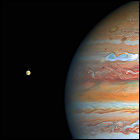 NASA and ESA announce that spectrographic analysis of Hubble Space Telescope data gathered during observations of Jupiter’s icy moon Europa reveals that Europa has a persistent atmosphere of water vapor, but only on the hemisphere of the moon that is opposite of the direction of its orbital motion. (This unusual effect had been predicted in computer modeling, but had not been directly observed until now.) The atmosphere is present in Hubble spectroscopy data as old as 1999 and as recent as 2015. The stability of the water vapor in the atmosphere is the real surprise find, since surface-based water was assumed to be in solid ice form.
NASA and ESA announce that spectrographic analysis of Hubble Space Telescope data gathered during observations of Jupiter’s icy moon Europa reveals that Europa has a persistent atmosphere of water vapor, but only on the hemisphere of the moon that is opposite of the direction of its orbital motion. (This unusual effect had been predicted in computer modeling, but had not been directly observed until now.) The atmosphere is present in Hubble spectroscopy data as old as 1999 and as recent as 2015. The stability of the water vapor in the atmosphere is the real surprise find, since surface-based water was assumed to be in solid ice form.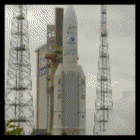 After well over a decade of development (and setbacks as the project fell in and out of favor with successive administrations of the U.S. government), the international James Webb Space Telescope is launched aboard an Ariane V rocket from the European Space Agency’s Kourou Space Center in French Guiana. Constructed and operated by NASA, the Webb Space Telescope is the larger successor to the Hubble Space Telescope, and its intricate, origami-like construction is expected to take a full month to deploy as the telescope travels to the L2 LaGrange point, well beyond the orbit of the moon. Its multi-segmented mirror is expected to see much more distant objects than Hubble was capable of resolving, possibly including the first galaxies to form in the history of the universe.
After well over a decade of development (and setbacks as the project fell in and out of favor with successive administrations of the U.S. government), the international James Webb Space Telescope is launched aboard an Ariane V rocket from the European Space Agency’s Kourou Space Center in French Guiana. Constructed and operated by NASA, the Webb Space Telescope is the larger successor to the Hubble Space Telescope, and its intricate, origami-like construction is expected to take a full month to deploy as the telescope travels to the L2 LaGrange point, well beyond the orbit of the moon. Its multi-segmented mirror is expected to see much more distant objects than Hubble was capable of resolving, possibly including the first galaxies to form in the history of the universe. Astronomer Dr. Frank Drake, one of the founders of SETI (the Search for Extra-Terrestrial Intelligences), dies at the age of 92. His fascinating with searching for life on other worlds began at a young age, and defined much of his life and career. In the 1960s, as part of a lecture, he devised the Drake Equation, a formula for calculating a very rough estimate of the possible number of civilizations capable of communicating across interstellar distances; this equation has been debated and challenged over the years, as well as gaining mainstream recognition after being cited in popular science programming (such as Carl Sagan’s Cosmos) and science fiction as well. In the 1970s, Drake and Sagan joined forces to create the “messages in bottles” affixed to the earliest space probes expected to break free of the solar system, including the Pioneer plaques and the golden records attached to Voyagers 1 and 2.
Astronomer Dr. Frank Drake, one of the founders of SETI (the Search for Extra-Terrestrial Intelligences), dies at the age of 92. His fascinating with searching for life on other worlds began at a young age, and defined much of his life and career. In the 1960s, as part of a lecture, he devised the Drake Equation, a formula for calculating a very rough estimate of the possible number of civilizations capable of communicating across interstellar distances; this equation has been debated and challenged over the years, as well as gaining mainstream recognition after being cited in popular science programming (such as Carl Sagan’s Cosmos) and science fiction as well. In the 1970s, Drake and Sagan joined forces to create the “messages in bottles” affixed to the earliest space probes expected to break free of the solar system, including the Pioneer plaques and the golden records attached to Voyagers 1 and 2.